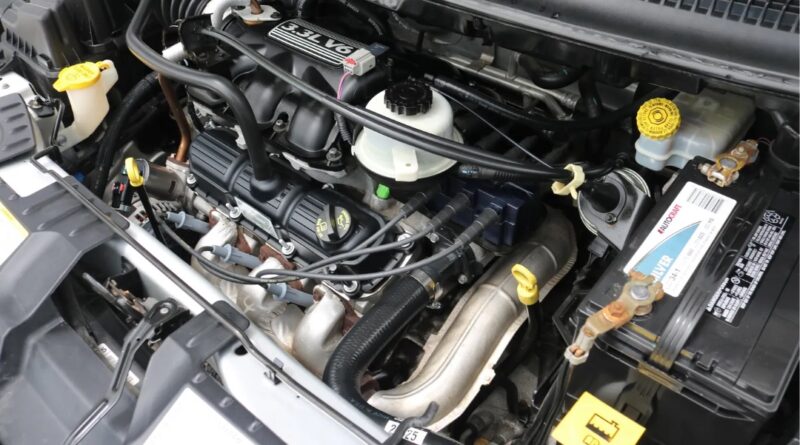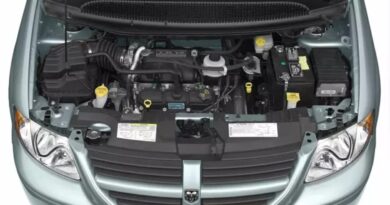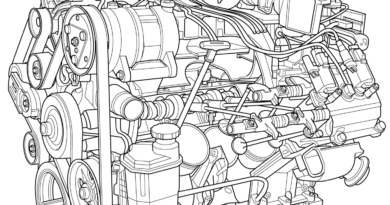How to Change 2005 Dodge Caravan Knock Sensor
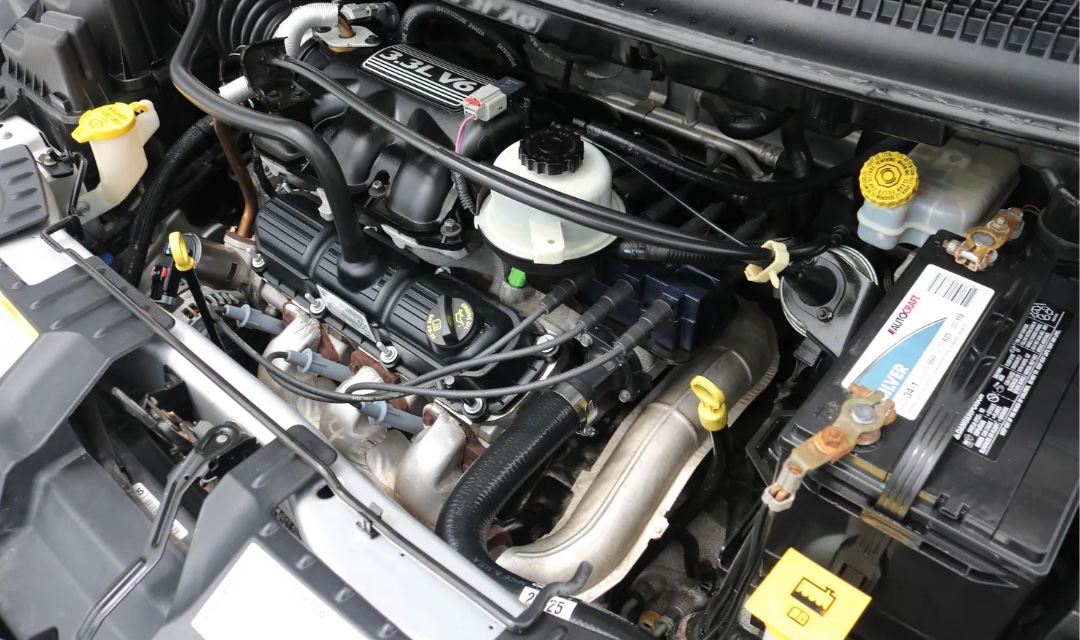
A knock sensor is an essential component threaded into the cylinder block of an engine, such as the one found in a 2005 Dodge Caravan. Its primary function is to detect and monitor engine vibrations that occur due to a phenomenon called detonation. Detonation refers to the abnormal combustion of fuel and air mixture within the cylinders, resulting in an undesirable knocking or pinging noise. The knock sensor is specifically designed to identify these vibrations and convert them into electrical signals, which are then sent to the engine control module for analysis. By detecting and alerting the engine control module of detonation, the knock sensor helps optimize engine performance and protect against potential damage caused by excessive knocking.
OPERATION
The knock sensor is a component in your engine that detects abnormal vibrations, often called “knocks,” in one of the cylinders. When it senses a knock, it sends a signal to the engine’s computer, known as the Powertrain Control Module (PCM). In response, the PCM adjusts the timing of the spark plugs for all cylinders.
The knock sensor contains a special material that vibrates constantly while the engine is running. This vibration generates an electrical signal, which is sent to the PCM. As the intensity of the vibration increases, the voltage of the signal from the knock sensor also increases.
The PCM uses the voltage signal from the knock sensor to determine if there is a knock occurring in the engine. If the signal goes above a certain level, the PCM remembers that value and adjusts the timing of the spark plugs to reduce the knock. The PCM adjusts the timing for all cylinders, not just the one experiencing the knock.
However, the PCM doesn’t pay attention to the knock sensor when the engine is idling. It only starts considering the sensor’s input when the engine speed goes beyond a specific value.
The PCM has two types of memory to handle timing adjustments based on knock detection. The long-term memory stores previous instances of knock in its memory, allowing it to make more informed decisions in the future. The PCM can be programmed to determine the maximum extent of timing adjustment based on this long-term memory.
On the other hand, short-term memory allows the PCM to quickly adjust the timing when it detects a knock. Under normal operating conditions (except for wide-open throttle), the short-term memory can retard the timing up to a preset limit. However, this short-term memory is reset every time you turn off the ignition.
Knock Sensor Replacement Guide for 2005 Dodge Caravan, Voyager, and Grand Caravan
The knock sensor is an important component in your vehicle’s engine that detects abnormal combustion or knocking. If you’re experiencing issues related to engine performance, replacing the knock sensor may be necessary. Follow these step-by-step procedures to swap out the old knock sensor with a new part.
This comprehensive guide presents the factory-recommended procedures for the removal and installation of the knock sensor, ensuring precise and accurate execution. The instructions provided are specifically tailored for the following 2005 models, covering a wide range of Chrysler and Dodge vehicles:
- Chrysler Caravan (Front Wheel Drive)
- Chrysler Town & Country (Front Wheel Drive)
- Dodge Caravan/Grand Caravan (Front Wheel Drive)
- Dodge Caravan C/V, Grand Caravan C/V (Front Wheel Drive)
- Chrysler Town & Country (All Wheel Drive)
- Dodge Grand Caravan (All Wheel Drive)
- Chrysler Voyager/Grand Voyager (Front Wheel Drive)
- Voyager/Grand Voyager (Front Wheel Drive, Left Hand Drive)
- Voyager/Grand Voyager (All Wheel Drive, Left Hand Drive)
- Voyager/Grand Voyager (Front Wheel Drive, Right Hand Drive)
REMOVAL – 2.4L Engine
- Begin by disconnecting the electrical connector from the knock sensor. Ensure the engine is turned off before proceeding.
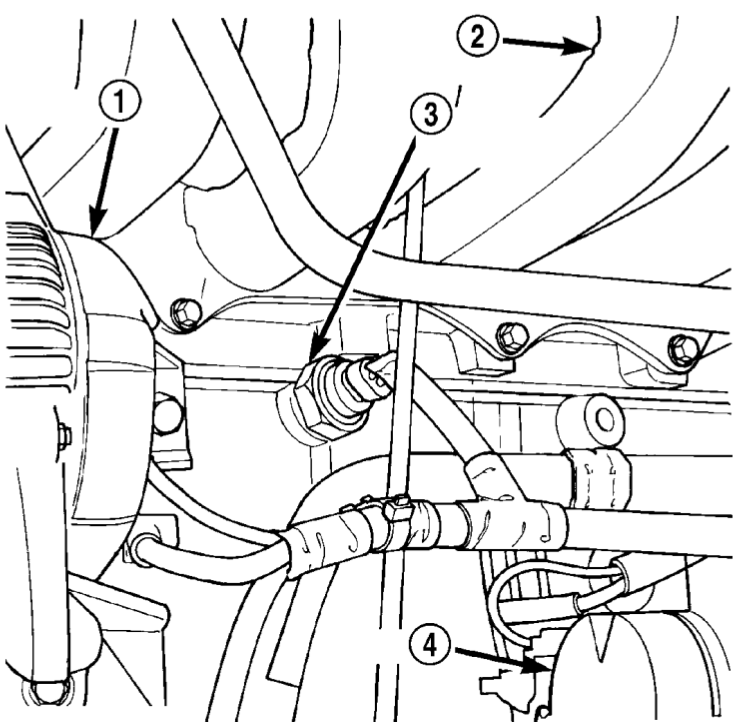
1. Generator 2. Intake Manifold 3. Knock Sensor 4. Starter - Locate the knock sensor, which can be found threaded into the side of the cylinder block in front of the starter. Use a crow foot socket to easily remove the knock sensor.
REMOVAL – 3.8L Engine
- To start, disconnect the negative battery cable to ensure safety during the procedure.
- Raise the vehicle and support it securely. If you have an All Wheel Drive (AWD) vehicle, you will need to remove the PTU (Power Transfer Unit) as well.
- Disconnect the electrical connector from the knock sensor.
- Use a crow foot socket to loosen and remove the knock sensor, which can be found threaded into the side of the cylinder block in the rear.
INSTALLATION – 2.4L Engine
- Take the new knock sensor and position it in place. Ensure it threads properly into the side of the cylinder block in front of the starter. Tighten the knock sensor to a torque of 10 N·m (7 ft. lbs.). Avoid over or under-tightening, as it can affect the knock sensor’s performance and potentially lead to improper spark control.

1. Generator 2. Intake Manifold 3. Knock Sensor 4. Starter - Attach the electrical connector to the new knock sensor securely.
INSTALLATION – 3.8L Engine
- Place the new knock sensor in position, ensuring it threads correctly into the side of the cylinder block in the rear. Tighten the knock sensor to a torque of 10 N·m (7 ft. lbs.). Avoid over or under-tightening, as it can affect the knock sensor’s performance and potentially lead to improper spark control.
- Attach the electrical connector to the new knock sensor securely.
- If you have an All Wheel Drive (AWD) vehicle, reinstall the PTU (Power Transfer Unit) for the rear wheels. Refer to the Transmission section for detailed instructions on PTU installation.
- Lower the vehicle safely.
- Finally, reconnect the negative battery cable to complete the replacement process.
By following these step-by-step procedures, you can easily replace the knock sensor in your 2005 Dodge Caravan, Voyager, or Grand Caravan. Remember to exercise caution and refer to your vehicle’s manual for any additional information specific to your model.

